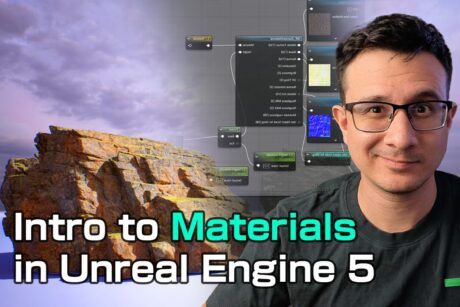Learn MATLAB Simulink to simulate electrical components and power systems. Master modeling and analysis in MATLAB Simulink for engineers. Read more.
I am Ahmed Mahdy an electrical power engineer, researcher, and the founder of Khadija Academy. I am also an electrical bestselling instructor teaching electrical power engineering. I have helped over 80,000 students from 198 countries achieve career success with simple and easy courses in the last 8 years. In addition, I have a YouTube educational engineering channel called" Khadija Academy", where I regularly post videos related to electrical engineering. I have received the award for the be
Access all courses in our library for only $9/month with All Access Pass
Get Started with All Access PassBuy Only This CourseAbout This Course
Who this course is for:
- Engineers and researchers in renewable energy and power systems
- Control system engineers and automation specialists
- Advanced students seeking expertise in MATLAB Simulink
What you’ll learn:
- Renewable Energy System Modeling
-
- Solar PV system simulation using MATLAB Simulink
- Wind energy system modeling and power curve analysis
- Advanced Control and Optimization Techniques
-
- PID controller design and tuning in Simulink
- Particle Swarm Optimization (PSO) for parameter selection
- Power System Protection and Fault Analysis
-
- Overvoltage and undervoltage detection with reclosure features
- Fault analysis in grid-connected PV systems (symmetrical and unsymmetrical)
- Masking and model callbacks for advanced simulation techniques
- Software Integration and Data Processing
-
- PSCAD-to-MATLAB integration for system-level analysis
- Matrix applications in MATLAB for electrical engineering
MATLAB/Simulink – Simulink Course for Electrical Engineering (Part 2)
This advanced MATLAB Simulink course expands your expertise beyond basic circuit modeling. You’ll explore renewable energy system simulations, PID control, fault detection, and optimization techniques, equipping you with practical skills for modern energy and control systems. If you’re looking for a comprehensive MATLAB course, this program provides hands-on experience with real-world applications.
Before diving into this advanced course, make sure you’ve built a strong foundation! Enroll in “MATLAB/Simulink – Simulink Course for Electrical Engineering (Part 1)” first to master the basics of circuit modeling and simulation. Start now to prepare for success!
Our Promise to You
By the end of this course, you’ll be able to design, simulate, and optimize renewable energy and control systems, making you proficient in advanced MATLAB Simulink applications.
10 Day Money Back Guarantee. If you are unsatisfied for any reason, simply contact us and we’ll give you a full refund. No questions asked.
Get started today!
Course Curriculum
| Section 1 - Applications On Matrices In MATLAB | |||
| Solving One Non Linear Equation In MATLAB Using Fzero Function | 00:00:00 | ||
| Example 1 On Solving Multiple Non Linear Equations in MATLAB Using Fsolve Function | 00:00:00 | ||
| Example 2 On Solving Multiple Non Linear Equations In Matlab Using Fsolve | 00:00:00 | ||
| Application Multi Level Inverter Part 1 | 00:00:00 | ||
| Application Multi Level Inverter Part 2 | 00:00:00 | ||
| Section 2 - Solar Energy Simulation Using Simulink In MATLAB | |||
| Simulation Of PV Cell In MATLAB And Obtaining V-I Characteristics | 00:00:00 | ||
| How To Solve The Single Output Problem In The To WorkSpace Function | 00:00:00 | ||
| Get A Complete Grid Connected PV Solar Energy System In MATLAB Simulink | 00:00:00 | ||
| Section 3 - MATLAB Simulation For A Wind Energy System | |||
| Introduction To MATLAB Simulation Of Wind Turbine | 00:00:00 | ||
| Introduction To CP Model And Lookup Table In MATLAB Simulink | 00:00:00 | ||
| CP Plotting In MATLAB Simulink | 00:00:00 | ||
| CP Lookup Table In MATLAB Simulink | 00:00:00 | ||
| Modeling And Simulation Of Wind Turbine Part 1 | 00:00:00 | ||
| Modeling And Simulation Of Wind Turbine Part 2 | 00:00:00 | ||
| Introduction To MPPT In MATLAB Simulink | 00:00:00 | ||
| MPPT Simulation In MATLAB Simulink | 00:00:00 | ||
| Section 4 - PSCAD To MATLAB | |||
| Importing Data From Pscad Program For Fault Location Detection To MATLAB Program | 00:00:00 | ||
| Section 5 - PID Controller In MATLAB | |||
| How To Implement PID Controller In Simulink Of MATLAB | 00:00:00 | ||
| Tuning A PID Controller In MATLAB Simulink | 00:00:00 | ||
| Section 6 - Application Of Particle Swarm Optimization (PSO) Algorithm | |||
| PID Tuning Using Particle Swarm Optimization Algorithm | 00:00:00 | ||
| Identifying The Execution Time Of A Script | 00:00:00 | ||
| Section 7 - Overvoltage And Undervoltage Fault Detection Scheme Design | |||
| Design Of An Overvoltage And Undervoltage Fault Detection Scheme | 00:00:00 | ||
| Adding Reclosure Feature To The Circuit Breaker | 00:00:00 | ||
| Section 8 - Masking In MATLAB Simulink | |||
| Creating A Subsystem | 00:00:00 | ||
| Masking Of A Subsystem And Promote Of A Parameter | 00:00:00 | ||
| Edit Parameters In Mask | 00:00:00 | ||
| Model Callbacks | 00:00:00 | ||
| Section 9 - Fault Analysis Of A Grid-Connected PV System In Simulink | |||
| Understanding And Preparing The Model | 00:00:00 | ||
| Adding Transmission Lines And Circuit Breakers | 00:00:00 | ||
| Applying Symmetrical And Unsymmetrical Faults To The System | 00:00:00 | ||
| How To Get Any Electrical Power Engineering Model In MATLAB Easily | 00:00:00 | ||
| Section 10 - Course Slides And Files | |||
| MATLAB Files | 00:00:00 | ||
| MATLAB Simulations Course Slides | 00:00:00 | ||
About This Course
Who this course is for:
- Engineers and researchers in renewable energy and power systems
- Control system engineers and automation specialists
- Advanced students seeking expertise in MATLAB Simulink
What you’ll learn:
- Renewable Energy System Modeling
-
- Solar PV system simulation using MATLAB Simulink
- Wind energy system modeling and power curve analysis
- Advanced Control and Optimization Techniques
-
- PID controller design and tuning in Simulink
- Particle Swarm Optimization (PSO) for parameter selection
- Power System Protection and Fault Analysis
-
- Overvoltage and undervoltage detection with reclosure features
- Fault analysis in grid-connected PV systems (symmetrical and unsymmetrical)
- Masking and model callbacks for advanced simulation techniques
- Software Integration and Data Processing
-
- PSCAD-to-MATLAB integration for system-level analysis
- Matrix applications in MATLAB for electrical engineering
MATLAB/Simulink – Simulink Course for Electrical Engineering (Part 2)
This advanced MATLAB Simulink course expands your expertise beyond basic circuit modeling. You’ll explore renewable energy system simulations, PID control, fault detection, and optimization techniques, equipping you with practical skills for modern energy and control systems. If you’re looking for a comprehensive MATLAB course, this program provides hands-on experience with real-world applications.
Before diving into this advanced course, make sure you’ve built a strong foundation! Enroll in “MATLAB/Simulink – Simulink Course for Electrical Engineering (Part 1)” first to master the basics of circuit modeling and simulation. Start now to prepare for success!
Our Promise to You
By the end of this course, you’ll be able to design, simulate, and optimize renewable energy and control systems, making you proficient in advanced MATLAB Simulink applications.
10 Day Money Back Guarantee. If you are unsatisfied for any reason, simply contact us and we’ll give you a full refund. No questions asked.
Get started today!
Course Curriculum
| Section 1 - Applications On Matrices In MATLAB | |||
| Solving One Non Linear Equation In MATLAB Using Fzero Function | 00:00:00 | ||
| Example 1 On Solving Multiple Non Linear Equations in MATLAB Using Fsolve Function | 00:00:00 | ||
| Example 2 On Solving Multiple Non Linear Equations In Matlab Using Fsolve | 00:00:00 | ||
| Application Multi Level Inverter Part 1 | 00:00:00 | ||
| Application Multi Level Inverter Part 2 | 00:00:00 | ||
| Section 2 - Solar Energy Simulation Using Simulink In MATLAB | |||
| Simulation Of PV Cell In MATLAB And Obtaining V-I Characteristics | 00:00:00 | ||
| How To Solve The Single Output Problem In The To WorkSpace Function | 00:00:00 | ||
| Get A Complete Grid Connected PV Solar Energy System In MATLAB Simulink | 00:00:00 | ||
| Section 3 - MATLAB Simulation For A Wind Energy System | |||
| Introduction To MATLAB Simulation Of Wind Turbine | 00:00:00 | ||
| Introduction To CP Model And Lookup Table In MATLAB Simulink | 00:00:00 | ||
| CP Plotting In MATLAB Simulink | 00:00:00 | ||
| CP Lookup Table In MATLAB Simulink | 00:00:00 | ||
| Modeling And Simulation Of Wind Turbine Part 1 | 00:00:00 | ||
| Modeling And Simulation Of Wind Turbine Part 2 | 00:00:00 | ||
| Introduction To MPPT In MATLAB Simulink | 00:00:00 | ||
| MPPT Simulation In MATLAB Simulink | 00:00:00 | ||
| Section 4 - PSCAD To MATLAB | |||
| Importing Data From Pscad Program For Fault Location Detection To MATLAB Program | 00:00:00 | ||
| Section 5 - PID Controller In MATLAB | |||
| How To Implement PID Controller In Simulink Of MATLAB | 00:00:00 | ||
| Tuning A PID Controller In MATLAB Simulink | 00:00:00 | ||
| Section 6 - Application Of Particle Swarm Optimization (PSO) Algorithm | |||
| PID Tuning Using Particle Swarm Optimization Algorithm | 00:00:00 | ||
| Identifying The Execution Time Of A Script | 00:00:00 | ||
| Section 7 - Overvoltage And Undervoltage Fault Detection Scheme Design | |||
| Design Of An Overvoltage And Undervoltage Fault Detection Scheme | 00:00:00 | ||
| Adding Reclosure Feature To The Circuit Breaker | 00:00:00 | ||
| Section 8 - Masking In MATLAB Simulink | |||
| Creating A Subsystem | 00:00:00 | ||
| Masking Of A Subsystem And Promote Of A Parameter | 00:00:00 | ||
| Edit Parameters In Mask | 00:00:00 | ||
| Model Callbacks | 00:00:00 | ||
| Section 9 - Fault Analysis Of A Grid-Connected PV System In Simulink | |||
| Understanding And Preparing The Model | 00:00:00 | ||
| Adding Transmission Lines And Circuit Breakers | 00:00:00 | ||
| Applying Symmetrical And Unsymmetrical Faults To The System | 00:00:00 | ||
| How To Get Any Electrical Power Engineering Model In MATLAB Easily | 00:00:00 | ||
| Section 10 - Course Slides And Files | |||
| MATLAB Files | 00:00:00 | ||
| MATLAB Simulations Course Slides | 00:00:00 | ||




